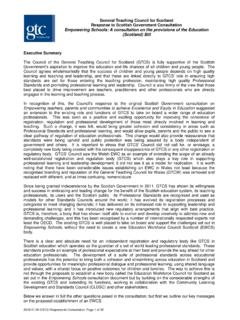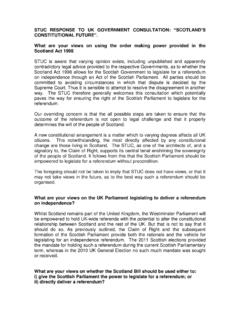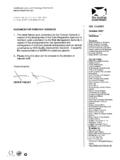Transcription of Biosecurity and Disinfection in Salmon Farming
1 Biosecurity and Disinfection in Salmon FarmingThis review was prepared at the request of scottish Aquaculture Forward (SAF), an independent group of scottish aquaculturists, veterinarians and consultants keen to advance the quality, health, environmental sustainability and reputation of scottish farmed fish and fish products in all its different forms. It is intended as an information source to advise Statutory Bodies, Farmers, Politicians and Media on the real issues affecting sustainable Aquaculture in the scottish context. IntroductionIn May 1998 the first outbreak of Infectious Salmon Anaemia (ISA) occurred in Scotland (Rodger et al. 1998). Until then the disease, caused by the ISA orthomyxovirus, had only been described from Norway ( Thorud & Djupvik 1988) and Canada (Bryne et al. 1998).
2 It subsequently spread, from its initial focus in Loch Nevis, to 11 sites on the scottish mainland, Skye and Shetland, in association with the movement of fish or well boats from infected loci (Stagg et al. 2001).ISA is a major clinical problem for the fish Farming industry, with outbreaks leading to serious economic losses due to death of affected fish and progressive spread to other sites. It is therefore placed on the EU list under Directives 91/67/EEC and 93/53/EEC, which requires the disease to be eradicated when it occurs. When the 1998 outbreak was reported immediate action was taken by the authorities to remove infectious foci and prevent further spread. Actions took the form of isolation of suspected stocks, compulsory slaughter where infection was found and isolation, quarantine and fallowing of contiguous areas, with enhanced Disinfection and Biosecurity ISA virus is not the only significant pathogen of farmed salmonids, its advent in scottish Salmon farms marked a watershed in management practices in the industry.
3 Until the advent of this serious outbreak, Biosecurity measures in the Salmon Farming industry in UK in general and information and arrangements for Disinfection were less than adequate. Detailed Biosecurity plans and Disinfection application protocols, which are commonplace in intensive pig and poultry production, had not yet been instituted and there was no proper identification of disinfectants that were both effective and environmentally acceptable. Due to the urgency of the circumstances, Disinfection procedures, largely Bradan Limited, 45 Longrow, Campbeltown, Argyll, Scotland PA28 6ER Tel/Fax. 01586 552228 email. on the use of hypochlorite at high concentration (100-1,000 mg/l in fresh water) were immediately introduced. Discharge of disinfectants to the environment is controlled under the Food and Environment Protection Act 1985 Part II Deposits in the Sea, as amended by the Environment Protection Act 1990 (FEPA) and The Control of Pollution Act 1974 as amended by the Water Act 1989 and the Environment Act 1995 (COPA).
4 COPA discharge consent is issued by the scottish Environment Protection Agency (SEPA) and must be obtained for discharges made, not only during emergency slaughter, but during any activities, such as net and cage Disinfection , at both cage sites and shore bases and for effluent Disinfection at processing plants. The scottish Environment Protection Agency is responsible for control of all discharges into the environment and maintains a presumption against the authorisation of the discharge of effluents containing active residual chlorine, where there is significant risk that this may lead to organochlorine production. The routine controls over use of such chlorine based disinfectants were set aside on a temporary basis at the onset of the ISA outbreak, in the form of a derogation to allow fish farmers and processors to implement effective procedures rapidly.
5 The controls have, however, been re-instated with the resolution of the ISA outbreak and the use of sodium hypochlorite and other active chlorine compounds, unless neutralised, stored and discharged through a SEPA approved discharge site, is once more Joint Working Group ReportIn 2000, the scottish Executive/ Aquaculture Industry Joint Working Group on ISA (JWG) issued a detailed report and set of recommendations for the future management of the ISA risk. The JWG recognised that the situation with regard to Disinfection , in respect to any future outbreak, was particularly unsatisfactory, declaring that at present there was insufficient data on the efficacy of more environmentally acceptable alternatives to sodium hypochlorite. The Group s recommendation was that an urgent review be carried out of possible acceptable alternatives to hypochlorite in relation to both efficacy and environmental acceptability (JWG Report 2000).
6 This review has not yet taken place, some three years after the recommendation was published. There are concerns within the industry, however, that not only is there an ever present risk of a recurrence of ISA but also the economically important virus diseases Infectious Pancreatic Necrosis (IPN) and Pancreas Disease (PD) are increasing in incidence and improved guidance on both efficacy and environmental acceptability are necessary. The present document has, therefore, been produced, in an attempt to address the environmental and health aspects of Biosecurity in aquaculture, at the behest of a group of commercial and industry operators including marine and freshwater finfish farmers, processors and veterinarians involved in fish production. It is hoped that it will inform the efforts of the Code of Practice Working Group, currently attempting to establish Bradan Limited, 45 Longrow, Campbeltown, Argyll, Scotland PA28 6ER Tel/Fax.
7 01586 552228 email. acceptable code of working practices for the industry and also the Authorities, within SEPA and the scottish Executive Environment Rural and Agriculture Department (SEERAD), which are ultimately responsible for the management of the environment and of fish health, in the national paper therefore reviews the health and safety and environmental aspects of the available products for aquaculture Disinfection and highlights the points that have to be addressed in relation to such a study. It also makes firm recommendations, based on published data, wherever possible, for efficacious, as far as can be determined, safe and environmentally acceptable Disinfection procedures. These would apply not only in the event of any future ISA outbreak but also for general use in day to day Biosecurity within scottish aquaculture.
8 Data has, where possible, been derived from peer review publications, but these are very limited in this field and recourse has also been made to UK, Australian and US Government Reports and official websites, company literature and commercial websites. Efficacy Since the author has no particular experience in Disinfection per se, only the public safety and environmental aspects, it is not possible to present authoritative primary efficacy recommendations, whether for ISA or other more general Disinfection requirements. Clearly, however, there is little value in reviewing the environmental acceptability of disinfectants against virus infections if they have poor virucidal activity, so the review is based on the general recommendations of suitable candidate compounds recommended in the JWG ISA Report viz.
9 Chloramine T Glutaraldehyde Iodophores Chlorine Dioxide Peracetic AcidFollowing consultation with veterinarians and the official DEFRA (Department for Environment Food and Rural Affairs, UK), USDA/APHIS (US Department of Agriculture/Animal and Plant Health Inspection Service) and AUSVETPLAN (Australian Veterinary Emergency Plan) websites, for those disinfectants generally recommended for agricultural epidemics such as Foot and Mouth disease, which also had published efficacy for fish viral and bacterial pathogens, the agricultural biocide Virkon S was added. As well as being reputedly the most universally proven veterinary biocide disinfectant, this formulated triple salt of potassium monopersulphate also has published efficacy data against the Salmon pathogens ISA and IPN viruses and Aeromonas salmonicida and Vibrio anguillarum (vide infra) as well as a range of other exotic fish pathogens.
10 It is also Bradan Limited, 45 Longrow, Campbeltown, Argyll, Scotland PA28 6ER Tel/Fax. 01586 552228 email. widely used and recommended by veterinarians in aquaculture, despite its absence from SEERAD s listing. When used in aquaculture it does not normally attract a maximum discharge level condition from SEPA as part of a discharge consent. (It was also, incidentally, I discovered, invented and patented by a distinguished scottish chemist, TRA Auchincloss).The reason for the exclusion of Virkon-S from the JWG list is puzzling, since it is used as the principal virucidal disinfectant biocide in the diagnostic laboratories of the two national fisheries research institutes, which advise government on aquaculture Disinfection policy. It is also one of only two disinfectants approved for use by the Norwegian Veterinary Authorities for well-boat and aquaculture site Disinfection .





